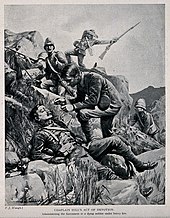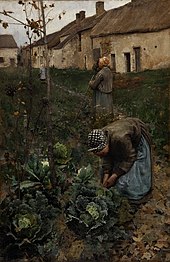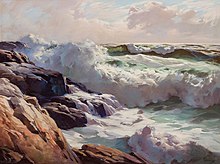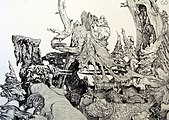Frederick Judd Waugh
Frederick Judd Waugh (born September 13, 1861 in Bordentown , New Jersey , † September 10, 1940 in Provincetown , Massachusetts ) was an American painter , illustrator and author . The artist with the nickname "The Wizard" achieved particular fame as a marine painter and was one of the most important representatives of his generation in this genre from the beginning of the 20th century. The much-traveled Waugh was a member of the National Academy of Design , and helped in the First World War, the United States Navy in the camouflage of ships.
Life
Youth and education
Frederick Judd Waugh was born in 1861 to the portrait and landscape painter Samuel Bell Waugh (1841-1885) and the miniature painter Mary Elizabeth Waugh (née Young) in Bordentown, New Jersey . He had a half-sister named Ida († 1919) who worked as a figure painter. Waugh grew up in Philadelphia , where he attended public schools and a military academy . He received his first artistic education from his father. From 1880 he studied for three years under Thomas Eakins and Thomas Pollock Anshutz at the Pennsylvania Academy of the Fine Arts . In the summer of 1882 he made his first trip to Europe, which took him to Paris and the French provinces, where he mainly practiced landscape painting. In 1883, Waugh moved to the Académie Julian in Paris , where he studied under William Adolphe Bouguereau and Tony Robert-Fleury . The following year he exhibited for the first time at the Salon de Paris and sent some of his paintings to exhibitions at the Pennsylvania Academy, the National Academy of Design, and the Art Institute of Chicago . In the summer he painted in the artists' colony Grez-sur-Loing and in Brittany . In 1885 he returned to Philadelphia to mark the impending death of his father.
Starts as a marine painter
Waugh spent the next seven years in his hometown, doing portraits and commercial work. In 1892 he married his former classmate Clara Eugenie Bunn, with whom he would have two children. After a trip through England and Scotland, he worked in a Paris studio, where he painted, among other things, the now-lost picture Consider the Lilies . He donated it to a church, which in return gave him financial support for a trip to the Channel Island of Sark . Waugh lived on the island from 1893 to 1895 and began to focus on marine painting there. His painting La Grande Greve , created there, was exhibited by the Royal Academy of Arts in 1894 . He then worked for around nine months in St Ives (Cornwall) , where he shared a studio with another artist. He spent several years in Bedfordshire and Hendon , where he also worked as an illustrator for The Graphic and Hamsworth Magazine . He lived with his family in London until 1907, but continued to paint seascapes in his studio in St Ives. After some of his works were turned down for exhibition at the Royal Academy, he returned to the States.
breakthrough
After spending 15 years abroad, he lived with relatives in Elizabeth , New Jersey , and then under the auspices of an art collector in Montclair . This enabled Waugh to quit his job as an illustrator, which enabled him to concentrate fully on marine painting. In January 1908 he painted his most famous seascape, The Roaring Forties , in a New York studio , which shows a view of the stormy central Atlantic . A patron acquired the picture and had it presented in the Metropolitan Museum , which brought the painter great public attention for the first time.
In 1909 Waugh was accepted as an associate and two years later as a full member of the National Academy of Design. His first solo exhibition in 1910 showed pictures he had painted in the previous two years on Bailey Island, Maine . His ambitious pirate image, The Buccaneers , won the Academy's Thomas B. Clarke Prize that same year. In 1915 he moved to Kent , Connecticut , where he lived until 1927. He often spent the summers at Monhegan and was inspired by this for his only book The Clan of Munes (1916). In 1921, every major art museum in the United States had at least one of his paintings.
Later years

During the First World War , Frederick J. Waugh was involved in a US Navy project to camouflage marine vessels. In 1918, due to his membership in the Academy of Design, he was called up as a camouflage designer in the responsible department in Washington, DC and worked there under the direction of his painter colleague Everett L. Warner. According to George Remington Havens , of all the ships Waugh had worked on, including the troop carrier USS Leviathan , only one was missing.
Waugh used his reputation now to create new material and made some trips, including 1920 to the Caribbean and 1922 to British Columbia . He spent his retirement in Provincetown , Massachusetts , near his son Coulton (1896–1973), who also worked as a painter. In doing so, he continued to enjoy commercial and critical success. From 1934 to 1938 he was the first artist to win the Carnegie Museum Audience Award in Pittsburgh five times in a row .
As reported by the New York Times , Frederick Judd Waugh died shortly before his 79th birthday in his Provincetown home in 1940 after a four-month illness.
plant

Frederick Judd Waugh is known as a versatile artist who, in addition to oil painting, also designed ex-libri , silver and copper objects and who participated in house building. Waugh's most important legacy is his numerous seascapes , which were created in Europe and America. His most frequent motifs include views of the open ocean - primarily the Atlantic - with waves and sky, but without ships or coasts. Early works such as Peasant Landscape (1883) show influences of the realistic open-air painting by Jules Bastien-Lepage . In an article entitled Some Words Upon Sea Painting (1910), the artist described his methodology: According to this, he observed the ocean and studied its movements by looking for “particularly attractive phases”. Once he was intimately familiar with the sea, he no longer had to paint from nature, but could also fall back on his memory. For example, he painted The Roaring Forties (1908) based on memories of his Atlantic crossing in the previous late autumn. He said to a friend:
"It is impossible to paint the sea in literal movement or to carry to the nostrils the tang of the salt sea brine (...) yet all these are somehow felt in a work of art."
"It is impossible to paint the sea in literal motion or to smell the smell of brine in your nostrils (...) and yet all this can somehow be felt in a work of art."
Waugh preferred the impasto - technology with a rugged, rough thickness on the whole image. The dyes should be applied as unmixed as possible to a canvas that has been prepared with a rough coat of dark paint. The Roaring Forties, for example, which meant his commercial breakthrough, is characterized by broad brushstrokes and clear, green colors. In addition to marine painting, the artist also made a name for himself as an illustrator. Among his most important images are the images created from 1899 to 1902 of the Second Boer War for the British magazine The Graphic and manufactured from 1914 to 1916 illustrations for his own fantasy - novel The Clan of Munes .
Much of his work is in the Edwin A. Ulrich Art Museums in Hyde Park , New York and Wichita , Kansas . At least one painting hangs in the Church of Saint Mary of the Harbor in Provincetown, where he died.
- Seascapes (1908–1921)
- The Clan of Munes (1914-1916)
Works (selection)
- 1883: Peasant Landscape . Oil on canvas, 90.8 × 60.9 cm.
- 1907: Southwesterly Gale, St. Ives . Oil on canvas, 76.5 × 127.2 cm.
- 1908: The Roaring Forties . Oil on canvas, 121.9 × 152.7 cm.
- 1908: Jersey City at Sunset . Oil on panel, 13.3 × 17.8 cm.
- 1908: Jersey City Waterfront . Oil on panel, 14 × 16.5 cm.
- 1908: Looking Toward Jersey City . Oil on panel, 13.3 × 17.8 cm.
- 1909: At the Base of the Cliff .
- 1909: The Great Deep . Oil on canvas, 152.1 × 182.7 cm.
- 1915: Heavy Surf . Oil on canvas, 71.6 × 91.8 cm.
- 1916: Illustrations for The Clan of Munes .
- 1920: Outermost Point . Oil on panel, 58.4 × 78.7 cm.
- 1921: Under the Trade Winds, Barbados . Oil on canvas, 63.5 × 76.2 cm.
- 1922: Rum Row . Oil on panel, 81.3 × 73.7 cm.
- 1930: Wild Weather . Oil on masonite, 75.9 × 122.2 cm.
Undated
- After the storm . Oil on canvas, 76.8 × 102.2 cm.
- Along the coast . Oil on panel.
- Crashing waves .
- Moonrise (Quarter Moon on Tumbling Seas) . Oil on canvas.
- The ocean . Oil on canvas, 100.3 × 125.7 cm.
- Smothering surf . Oil on canvas.
- Still life . Oil on panel, 35.6 × 45.7 cm.
Awards
- 1910: Thomas B. Clarke Prize from the National Academy of Design
- 1934–1938: Popular Prize of the Carnegie Museum of Art
literature
- Frederick J. Waugh: Some Words Upon Sea Painting. In: Palette and Bench. 3, Nov. 1910, pp. 32-33.
- Anna Seaton-Schmidt: An American Marine Painter, Frederick J. Waugh. In: International Studio. 51, February 1914, pp. 273-278.
- Henry Rankin Poore: The Many-Sided Waugh. In: International Studio. 74, December 1921, pp. 124-135.
- George Remington Havens : Frederick Waugh. In: American Artist. January 31, 1967, pp. 30-37 and 68-69.
- George Remington Havens: Frederick J. Waugh, American Marine Painer. University of Maine Press , Orono 1969.
- Waugh, Frederick Judd . In: Hans Vollmer (Hrsg.): General lexicon of fine artists from antiquity to the present . Founded by Ulrich Thieme and Felix Becker . tape 35 : Libra-Wilhelmson . EA Seemann, Leipzig 1942.
Web links
Individual evidence
- ↑ a b c d e f g h Doreen Bolger Burke: Frederick J. Waugh. In: American Paintings in the Metropolitan Museum of Art. Volume III, A Catalog of Works by Artists Born between 1846 and 1864. Metropolitan Museum of Art , New York City 1980, ISBN 0-87099-244-9 , pp. 409-412 . Online , accessed May 23, 2019.
- ^ A b Jan Kelsey: Waugh, Frederick Judd. In: Encyclopedia of New Jersey. Rutgers University Press , New Brunswick 2004, ISBN 0-8135-3325-2 , p. 855 (English).
- ^ Henry Rankin Poore: The Many-Sided Waugh. In: International Studio. 74 (December 1921), pp. 134-135 (English).
- ↑ Roy R. Behrens: Camoupedia: A Compendium of Research on Art, Architecture and Camouflage. Bobolink Books, Dysart 2009, ISBN 978-0-9713244-6-6 , pp. 374-376 (English).
- ^ Everett L. Warner: Fooling the Iron Fish. The Inside Story of Marine Camouflage. In: Everybody's Magazine. New York City, November 1919, pp. 102-109.
- ↑ George Remington Havens : Frederick J. Waugh, American Marine Painer. University of Maine Press , Orono 1969, p. 154 (English).
- ^ A b 150 Years of Philadelphia Painters and Paintings. Selections from the Sewell C. Biggs Museum of Art, Philadelphia 1999, ISBN 1-893287-01-7 , pp. 42-43 (English).
- ^ FJ Waugh Is Dead; Marine Artist, 79; Only Painter to Win Popular Prize at Carnegie Institute, Pittsburgh, Five Times Was Also an Architect Planned Provincetown Church - His Works in Galleries Here and in Europe. In: The New York Times . September 11, 1940, p. 34. Online archive .
- ^ The Church of Saint Mary of the Harbor. Retrieved May 23, 2019 .
| personal data | |
|---|---|
| SURNAME | Waugh, Frederick Judd |
| BRIEF DESCRIPTION | American painter, illustrator, and author |
| DATE OF BIRTH | September 13, 1861 |
| PLACE OF BIRTH | Bordentown , New Jersey |
| DATE OF DEATH | September 10, 1940 |
| Place of death | Provincetown , Massachusetts |











